物流专业英语1
- 格式:ppt
- 大小:2.93 MB
- 文档页数:49
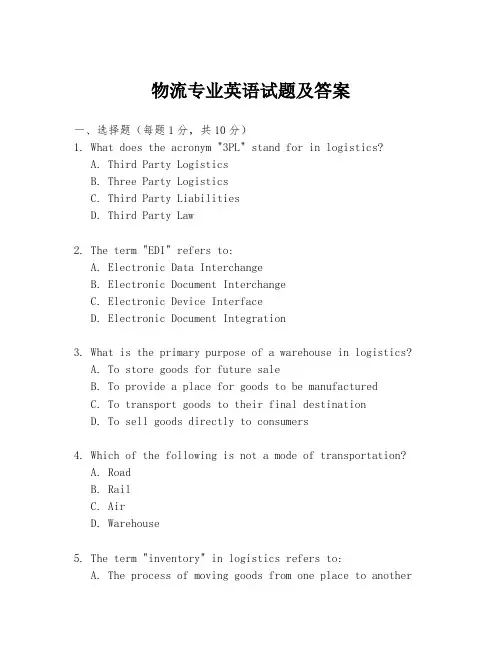
物流专业英语试题及答案一、选择题(每题1分,共10分)1. What does the acronym "3PL" stand for in logistics?A. Third Party LogisticsB. Three Party LogisticsC. Third Party LiabilitiesD. Third Party Law2. The term "EDI" refers to:A. Electronic Data InterchangeB. Electronic Document InterchangeC. Electronic Device InterfaceD. Electronic Document Integration3. What is the primary purpose of a warehouse in logistics?A. To store goods for future saleB. To provide a place for goods to be manufacturedC. To transport goods to their final destinationD. To sell goods directly to consumers4. Which of the following is not a mode of transportation?A. RoadB. RailC. AirD. Warehouse5. The term "inventory" in logistics refers to:A. The process of moving goods from one place to anotherB. The goods that are held in stock awaiting saleC. The process of receiving goods from suppliersD. The process of delivering goods to customers6. What is the role of a logistics manager?A. To manage the financial aspects of a companyB. To oversee the operations of a logistics departmentC. To design and manufacture productsD. To handle customer service inquiries7. Which of the following is a type of transportation document?A. Bill of LadingB. Bill of SaleC. Bill of ExchangeD. Bill of Rights8. What is the meaning of "LTL" in logistics?A. Less Than LoadB. Large Transport LoadC. Long Term LeaseD. Limited Time Limit9. The term "drop shipping" refers to a method where:A. The seller stores and ships the goods themselvesB. The manufacturer ships the goods directly to the customerC. The goods are shipped from one warehouse to anotherD. The goods are shipped to a central distribution center10. Which of the following is not a function of supply chainmanagement?A. PlanningB. SourcingC. ManufacturingD. Advertising答案:1-5 A A A A B6-10 B A A B D二、填空题(每题1分,共10分)1. The process of managing the flow of goods and information from the point of origin to the point of consumption is known as the _______ chain.2. In logistics, the term "lead time" refers to the _______ it takes for an order to be delivered after it has been placed.3. The acronym "FCL" stands for _______ Container Load.4. A _______ is a person or company that arranges the transportation of goods for others.5. The term "cross docking" refers to the practice of _______ goods as they are received and shipping them out without storing them.6. A _______ is a document that provides evidence of the terms of a contract for the transportation of goods.7. The process of managing the movement and storage of goods from raw material stage to the finished goods stage is known as _______ management.8. The term "hub-and-spoke" refers to a _______ model where goods are transported to a central hub and then distributed to various locations.9. The acronym "TMS" stands for _______ Management System.10. The _______ is the person responsible for ensuring that the cargo is properly loaded, secured, and unloaded.答案:1. supply2. time3. Full4. freight forwarder5. unloading and reloading6. contract of carriage7. inventory8. logistics9. Transportation10. stevedore三、简答题(每题5分,共20分)1. 简述物流中的“Just-In-Time”(JIT)库存管理的概念。

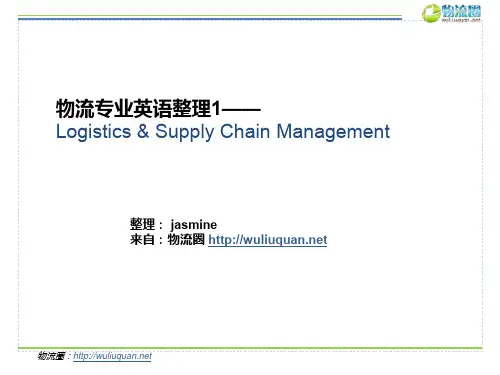
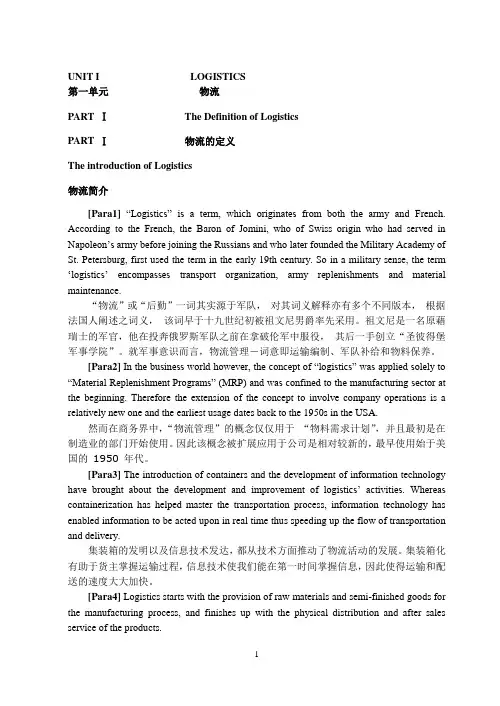
UNIT I LOGISTICS第一单元物流PART ⅠThe Definition of LogisticsPART Ⅰ物流的定义The introduction of Logistics物流简介[Para1]“Logistics” is a term, which originates from both the army an d French. According to the French, the Baron of Jomini, who of Swiss origin who had served in Napoleon’s army before joining the Russians and who later founded the Military Academy of St. Petersburg, first used the term in the early 19th century. So in a military sense, the term ‘logistics’ encompasses transport organization, army replenishments and material maintenance.“物流”或“后勤”一词其实源于军队,对其词义解释亦有多个不同版本,根据法国人阐述之词义,该词早于十九世纪初被祖文尼男爵率先采用。
祖文尼是一名原藉瑞士的军官,他在投奔俄罗斯军队之前在拿破伦军中服役,其后一手创立“圣彼得堡军事学院”。
就军事意识而言,物流管理―词意即运输编制、军队补给和物料保养。
[Para2] In the business world however, the concept of “logistics” was applied solely to “Material Replenishment Programs” (MRP) and was confined to the manufacturing sector at the beginning. Therefore the extension of the concept to involve company operations is a relatively new one and the earliest usage dates back to the 1950s in the USA.然而在商务界中,“物流管理”的概念仅仅用于“物料需求计划”,并且最初是在制造业的部门开始使用。
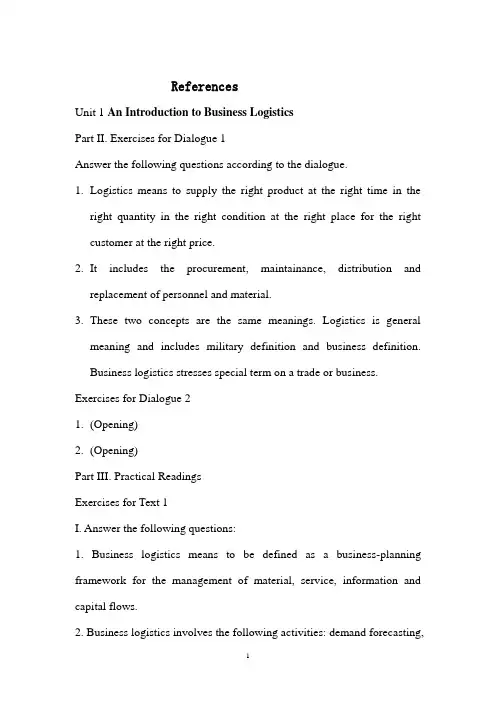
ReferencesUnit 1 An Introduction to Business LogisticsPart II. Exercises for Dialogue 1Answer the following questions according to the dialogue.1.Logistics means to supply the right product at the right time in theright quantity in the right condition at the right place for the right customer at the right price.2.It includes the procurement, maintainance, distribution andreplacement of personnel and material.3.These two concepts are the same meanings. Logistics is generalmeaning and includes military definition and business definition.Business logistics stresses special term on a trade or business. Exercises for Dialogue 21.(Opening)2.(Opening)Part III. Practical ReadingsExercises for Text 1I. Answer the following questions:1. Business logistics means to be defined as a business-planning framework for the management of material, service, information and capital flows.2. Business logistics involves the following activities: demand forecasting,procurement, materials handling, packaging, warehouse and inventory management, ordering processing, logistics communications, transport, customer service and so on.3. The role of logistics is to maintain the balance between the minute details and the main elements involved in a product.II.1.商务物流管理有不同版本的不同定义 2 必要资源的利用3. 逆向货物的搬运4. 人员和材料的补充5. 复杂信息6. 现代的商业环境7. 需求预测8. 设施场地选择9. 公司最重要的财富10. 公司战略抉择走势评定III. definitions—heart---output---service---strategyIV. 1. 这一非常宽广的物流观点把单一的供应链与贸易公司的方方面面整合在一起。


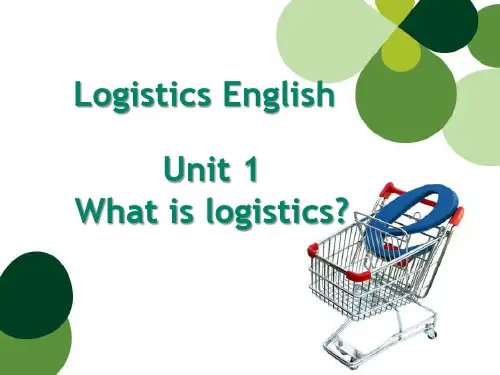
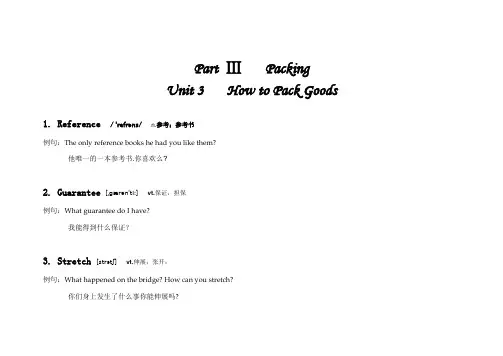
Part ⅢPackingUnit 3 How to Pack Goods 1. Reference /ˈrefrəns/ n.参考;参考书例句:The only reference books he had you like them?他唯一的一本参考书.你喜欢么?2. Guarantee [ˌɡærənˈti:]vt.保证,担保例句:What guarantee do I have?我能得到什么保证?3. Stretch[strɛtʃ] vt.伸展;张开;例句:What happened on the bridge? How can you stretch?你们身上发生了什么事你能伸展吗?4. rural[ˈruərəl] adj.乡下的,农村的;例句:But lots of the excess was in more rural areas.但更多的剩余房屋坐落于更加农村的地区。
Part ⅣShipmentUnit 1 Terms of Shipment 1. Warehouse[ˈwɛəhaus]n.仓库,货栈;& vt.把…放入或存入仓库;例句:Coordinate the warehouse resources of the company.协调公司的仓库资源。
2. Reship [,riː'ʃɪp]vi. 再上船例句:However, Covers and rings are made in Asia and it would not be feasible, to reship , for cost reasons. 只因盖和环都是在亚洲制造让成重装增加了运费,所以是不可行的。
3. occur[əˈkə:] vi.发生;出现;闪现例句:Where did the shooting occur? To the north.在哪里发生这次枪战的?在小镇北边.4. delivery[diˈlivəri] n.传送,投递例句:Businesses that depend on just-in-time delivery cannot tolerate lateness.依赖准时交货的企业不能容忍货物迟交。

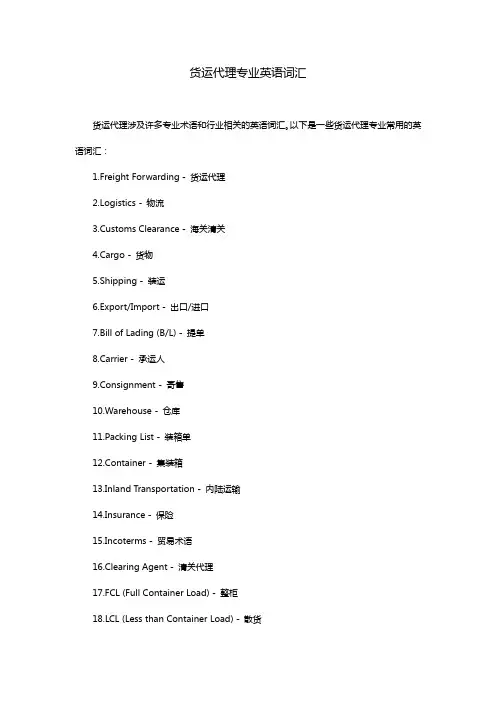
货运代理专业英语词汇货运代理涉及许多专业术语和行业相关的英语词汇。
以下是一些货运代理专业常用的英语词汇:1.Freight Forwarding - 货运代理2.Logistics - 物流3.Customs Clearance - 海关清关4.Cargo - 货物5.Shipping - 装运6.Export/Import - 出口/进口7.Bill of Lading (B/L) - 提单8.Carrier - 承运人9.Consignment - 寄售10.Warehouse - 仓库11.Packing List - 装箱单12.Container - 集装箱13.Inland Transportation - 内陆运输14.Insurance - 保险15.Incoterms - 贸易术语16.Clearing Agent - 清关代理17.FCL (Full Container Load) - 整柜18.LCL (Less than Container Load) - 散货19.AWB (Air Waybill) - 空运提单20.T ariff - 关税21.Demurrage - 滞期费22.Transshipment - 转运23.ETA (Estimated Time of Arrival) - 预计到达时间24.ETD (Estimated Time of Departure) - 预计出发时间25.Manifest - 货物清单这些术语在货运代理行业中非常常见,对于处理货物运输、海关事务、保险和物流管理等方面都至关重要。
熟悉并掌握这些词汇能够帮助从业人员更好地理解和处理货运代理业务。
一1物流师:Logistician2物流策略联盟:Logistics alliance3物流审计:Logistics audit4物流生涯:Logistics career5物流工程:Logistics engineering6物流费用:Logistics fees7物流弹性:Logistics flexibility8物流信息系统与通信系统包含托运、运送、仓储和通信的信息系统Logistics information and telecommunications system(LITS) 9委托物流:Logistics outsourcing10物流需求规划:Logistics requirement planning11物流服务业:Logistics service industry12国内物流:Domestic logistics13全球物流:Global logistics14物流反映时间:Logistics response time15环保物流:Green Logistics二1责任归属:accountability2脑力激荡发:Brainstorming3商业物流:Business logistics4专业物流师:Certified Professional Logistician(CPL)5物流主管:Chief logistics officer6差别物流:Differentiated distribution7一般货物运送业:General commodities carrier8理货成本:Handing casts9跨州运送者:Interstate carrier10国际标准书号:International Standard Book Number(ISNB)11国际物流:International logistics12仓库管理系统:Warehouse managing system三1会计账本、记账成本:Accounting cost2作业基础成本法:Activity based costing3代理成本:Agency cost4平均成本法:Average cost method5损益平衡点:Break-even point6资本预算评估:Capital budgeting7存货持有成本:Carrying costs8可控制成本:Controllable costs9物流成本递减:Decreasing logistics costs10外部成本:External cost11固定成本:Fixed cost12联合成本:Joint cost13销售丧失成本:Lost sales cost14下订单的成本:Ordering cost15歇业成本:Shut-down cost16利润最大化:Skimming price17标准成本:Standard cost18开办成本:Start-up costs四1运费优待:Aggregate tender rate2联合包装:Banded pack3顺序托运单:Bill of Lading,order4账单上的货重:Billed weight5空重:Deadweight6倾斜式输送机:Declining conveyor7悬吊式运输:Goods on hanger(GOH)8汽车货运业:Hauler9高速行进中侧重:High speed weight-in-motion(HSWIN)10工业包装:Industrial packaging11轻卡车:Light trucks12长途短途差别取价:Long-haul-short-haul discrimination 13零担运输:LTL shipment14运送方式:Method of shipment15汽车运输业合理运费:Motor carrier reasonable rate16包裹:Package17包裹运送业:Package hauler18套装软件:Package software19托盘:Pallet五1售后服务:After-sales service2延迟订单:Back order3客户态度:Customer attitude4客户导向:Customer driven5自领:Customer pickup6客户关系管理:Customer relation management7客户往来保持:Customer retention8客户满意:Customer satisfaction9定做软件:Customer software10客户周转率:Customer turnover rate11客户价值:Customer value六1订单后组装:Assembly-to-order2自动仓储系统:Automated storage and retrieval system3可用存货:Available inventory4月台:Dock5月台缓冲垫:Dock bumpers6自行组装:Do-it-yourself7高背集装箱:High cube container8高密度负荷:High-density load9存货余额:Inventory balances10存货模式:Inventory modeling11装载率:Load factor12负荷比:Load ratio13装卸费:Loading and unloading fees14托盘式货架:Pallet rack15拣货时间:Picker time16平车载运拖车:Trailer-on-flatcar七1买方拍卖:Buyers auction2集中采购:Centralized procurement3采购经理认证:Certified Purchasing Manager4联合采购:Cooperative buying5经济订购区:Economic order interval6经济订购量:Economic order quantity7购买4个O:Four Os of purchasing8全球采购:Global sourcing9订单履行:Order filling10采购订单:Purchase order11采购前置时间:Purchasing lead time12购货退回或折让:Purchase returns and allowance。
——Introduction to logistics——物流导论1. 物流定义物流,物流中心,以及物料的流动特性都被称为物流。
物流最初形成于美国,被称作“实物配送”(PD),“实物分配”或者“货物传送”。
在20世纪60年代后,日本引入了这样的概念, 即:物流是实现产品和消费品之间的管理、运输、物流搬运、包装等联系的过程,并且作为一种信息角色的支持来控制这类功能。
它扮演在销售物料中的桥梁角色。
物流是一个中国乃至全世界的热门语题。
虽然它已经不是一个新生事物了,但是不少人对物流的认识仍然有限。
物流知识正是本教科书的题材。
人们往往将物流称为货物流通,是的,这部分是正确的,但是物流远远不止这些。
那么物流究竟是指什么呢?当你看到术语“物流”时,你可能会意外的发现存在着各种不同版本的定义,每种都各有不同的含义。
为了避免可能发生的对物流含义的误解,本书采用美国供应链管理专业协会(前身为美国物流管理协会)目前的定义,该协会是全世界物流专业领城中最著名的组织。
根据美国物流管理协会,物流是指以满足客户需求为目的,对货物、服务以及相关信息从原产地到消费者的高效、有效流动及储存进行计划、实施和控制的过程。
这是一个相当长的定义,为了更好地理解,我们来更详细分析它。
1.1 这是一个“计划、实施和控制过程”首先,物流是一个“计划,实施和控制”的过程。
特别重要的是“和”这个词,它暗示出物流应该涵盖三个活动,计划、实施、控制,不只是其中的一个或两个。
不过有人认为,现代物流更多指的是实施而不是物流策略的规划。
1.2 关于“有效与高效流动和储存”请注意,该定义还提到了“有效和高效流动和储存”。
一般来说,效果可以被看作是“一个公司在他们所言及的将要做的工作方面做得怎么样”。
例如,如果一家公司承诺,所有订单将在24小时内收到,那么效果是指在实际中装运发货并在24小时内收到的订单所占的比例。
相比之下,效率可以被认为是为达到公司承诺,资源被利用的好坏程度。